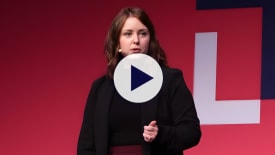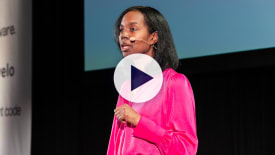
Latest videos
-

The joy of being wrong
Discover how rethinking assumptions drives better decisions, strengthens leadership, and builds more adaptive, collaborative teams.
-

The AI-augmented team: Rethinking roles, skills, and leadership
Explore how AI assistants and agents are reshaping team structures, required skills, and leadership in modern engineering organizations.
-

Making AI work for you: Examining and enhancing your developers’ workflows
Learn how to assess, adapt, and optimize developer workflows with AI to enhance collaboration, productivity, and measurable impact.
-
 In partnership with incident.io
In partnership with incident.ioBeyond the code: hiring for cultural alignment
Learn strategies to assess cultural alignment in engineering hiring, balancing technical skills with authentic evaluation of team fit.
-

Estimation is a waste of time
Learn to replace inaccurate estimates with data-driven probabilistic forecasting, dramatically improving delivery predictability and stakeholder relationships.
-

No one needs me (and that’s the point)
Learn how to build autonomous teams that thrive without you, so you can focus on higher-impact leadership work.
-

Leading sustainably when everything is on fire
Learn how to lead effectively in chaos by building organizational capital and adapting your mindset for tough times.
Highlights from our conferences

Measure for Change
Picking metrics is one thing. But the harder decisions lie in what to do with them afterward.
View all videos from LeadDev London

Drive product gaps as an engineering leader
Discover practical strategies for engineering leaders to influence product development effectively, even in the absence of strong product management and a clear company vision.
view all videos from LeadDev NEW YORK

Growth in a downturn
In this talk, Smruti Patel asks, if hyper-growth is marked by spending more to make more, what does building for enduring growth look like?
view all videos from LeadDev berlin

Idea to Innovation
Join me as we embark on a journey to dissect the anatomy of innovation, uncover strategies to unlock the full potential of ideas, and transform them into impactful realities. Let’s build a strong culture of innovation, and make sure that it is not just a buzzword but a tangible outcome.
view all videos from staffplus london

Slack enterprise key management: Senior to staff lessons
Explore the key lessons and skills Audrei gained during their first Staff+ project, Slack Enterprise Key Management. This talk offers insights for anyone growing in their Staff+ career.
view all videos from staffplus NEW YORK
All videos
-

How inclusive leaders stay current
Payam Azadi looks at how as senior leaders with busy lives and diverse teams, how can we best approach staying up to date? In this presentation, I’ll break down how to identify the right goals and opportunities for learning, and useful strategies you can use to reach them.
-

Using principles of observability to drive your professional growth
As you grow in your career, it can be harder and harder to assess personal progress. When you’re a leader with larger goals and longer-term projects, feedback loops lengthen. By drawing on the same principles of observability that we use when building software, engineering leaders can shorten the feedback cycle and take a data-driven approach to guide their own professional growth.
-

Engineering, everywhere, all at once: rethinking value as an engineering leader
Christian Wong looks at how applying some simple techniques – adapted from product discovery – we can identify potential areas of opportunity, position ourselves to act with more intent in our collegial relationships, and then engage in a way that allows us to build the knowledge and context we need.
-

How to succeed as a frontend developer today
The frontend landscape is changing at an incredible rate – how do successful engineers keep up?
-

Shifting the mindset of delegation – Your secret weapon to leadership at scale
Marta Jasinska gives you some tools that will help you understand the challenges ahead and techniques I developed over years for moving past them.
-

De-coding the technical interview process: Emma Bostian in conversation
What if you had a cheat code for acing technical interviews?
-

From zero to “Brands that Matter” – improving scientific discovery during a pandemic
Vic Vijayakumar tells the story of building a world-class platform starting from zero, and how technical decision-making isn’t always glamorous.
-

Leading from Incidents: How past incidents can be used to guide company decisions
Nora Jones will dive into how we can get the most out of incidents before they become our culture in a way we didn’t intend.
-

Doing the right thing, better: How to lead with efficiency in mind
Lena Reinhard will help you change the way you think and operate, and will help you be the leader that your business and your team needs during this time of uncertainty.
-

Engineering without borders
Building a large scale project is never easy, but it becomes even more challenging when you’re working with a brand new team scattered across different time zones. Throw in a global pandemic, and you have a recipe for potential disaster.
-

Exploring A/B Testing: Leemay Nassery in conversation
Leemay lays out the fundamentals of A/B testing
-

Remote Engineering Management: Alexandra Sunderland in conversation
What makes great remote leadership?
-

Happy teams don’t leave
To retain talent, engineering leaders need to establish an engaging culture within their teams
-

Manager’s remorse: when retention isn’t worth the price
A good manager knows how to retain talented team members. A great manager knows when not to.
-

Purpose: Glue for Talent
Talent today seeks higher purpose and meaning in their work. Successful businesses hear this and respond.
-

The promotion campaign
Without you leading a successful promotion campaign, that promotion is likely to fail, leaving you with disappointed engineers.
-

So you want to identify and nurture high performers?
Providing growth opportunities for the engineers in your team goes a long way toward motivating and retaining talent.
-

Alignment and clarity on promotions
As a manager, your role is to bring alignment and clarity to promotions
-

The impact of impact on motivation
Motivation is key, but how do you and your team stay connected to that motivation in the day-to-day?
-

Inclusive hiring is not a checkmark
Inclusion is the foundation of creating a level playing field for employees with all backgrounds to be heard, to be challenged, and to have an impact.
-

What’s fair?
How do people leaders impact the scales of fairness when they’re trying to be effective?
-

Why is inclusion important and what are the aspects of an inclusive team?
Diversity is important, but at the same time, if we do not have an inclusive environment, the diverse teams we build can fall apart.

